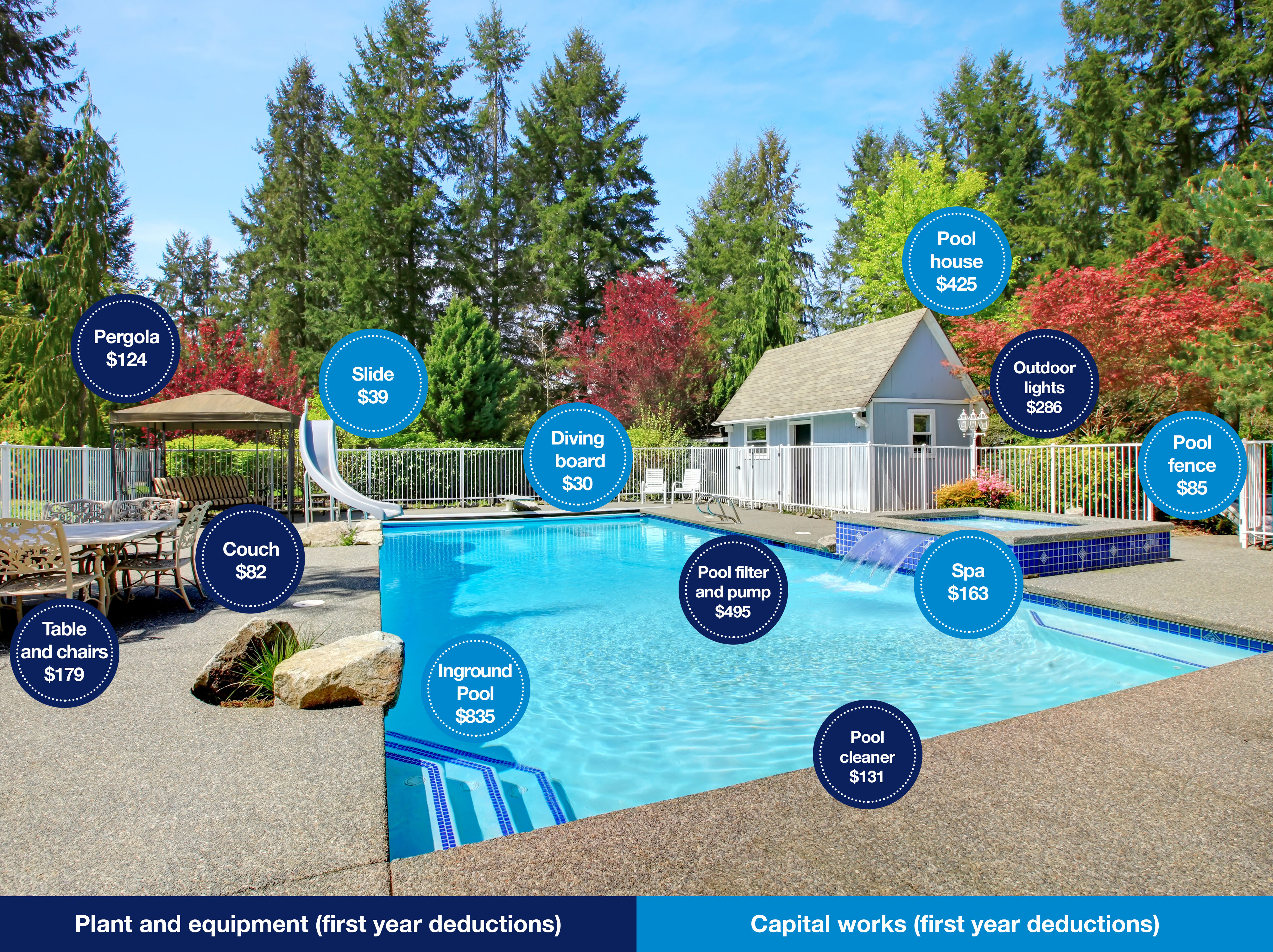What you can claim in the great outdoors
Contact
What you can claim in the great outdoors
Owners of income-producing properties can claim the wear and tear of certain outdoor structures and assets as a depreciation deduction when completing their annual income tax returns with their accountant.
With the warmer weather fast approaching, many people are enjoying spending more time outdoors.
Property investors should look outdoors too, since outdoor structures, fixtures and fittings may carry significant tax depreciation deductions.
Owners of income-producing properties can claim the wear and tear of certain outdoor structures and assets as a depreciation deduction when completing their annual income tax returns with their accountant.
These depreciation deductions are split into two categories, ‘Division 43: Capital works allowance’ and ‘Division 40: Plant and equipment’ depreciation.
Examples of eligible capital works, or structural depreciable assets, include things like pool houses or sheds, inground swimming pools, fencing, awnings, shade sails, pavers, concrete slabs, clothes lines, balconies and patio roofing.
Click here to request a tax depreciation schedule quote from BMT
The Australian Taxation Office (ATO) allows capital works deductions to be claimed at a rate of 2.5 per cent or 4 per cent, depending on the date on which construction began, the type of capital works, and how they're used. This is over the ATO specified 40-year life of the property.
Plant and equipment items are easily removable depreciable assets and include things like outdoor furniture, pergolas, garbage bins, freestanding barbecues, outdoor lights including solar garden lights and gardening watering systems.
Plant and equipment assets are assigned an effective life and depreciation rate under which the depreciation is calculated.
Looking at the image below, you can see the owner of this property can claim $1,577 in capital works depreciation deductions and $1,297 in plant and equipment deductions within the first year.
This is a total of $2,874 in tax deductions that may otherwise have gone unclaimed.
The beauty of this is that depreciation is a non-cash deduction, meaning that investors don’t need to spend anything additional to claim this benefit.
Source: BMT
At this time of year, many investors find themselves wanting to making improvements to the outside of their investment property to raise the appeal of their property and increase the rental income.
If you’re undertaking renovations to your investment property any time soon, it’s advisable to be aware of legislative changes introduced in 2017 regarding plant and equipment assets.
If you purchased your investment property after 7.30pm on 9 May 2017, one of the stipulations is that you can’t claim deductions for the ‘decline in value of previously used plant and equipment in rental premises used for residential accommodation’.
This means if you choose to live in the property while renovating it, you’ll miss out on valuable depreciation deductions because the new assets installed are ‘previously used’.
Assets acquired before 9 May 2017 are subject to specific conditions so it’s important to discuss these with a specialist Quantity Surveyor to ensure you’re complying with the regulations while still claiming the deductions you’re entitled to.
If you purchased new plant and equipment after 1 July 2017, you can continue to claim a deduction over the effective life of the asset under Division 40.
If you’re planning on making any additional structural changes to your property or are planning to dispose of, or ‘scrap’ items, a Quantity Surveyor can assist in determining any additional claims for you. If an asset is removed from a property, it may have a residual depreciable value.
This can be claimed as an immediate tax write-off in the financial year the asset is removed, and the process is known as ‘scrapping’.
Considering the complexities involved, particularly with the ATO legislative changes, investors are encouraged to seek advice.
A specialist Quantity Surveyor is qualified to calculate values and construction costs of assets including structures, fixtures and fittings and can ensure you are claiming all that you’re entitled to.
It’s recommended you seek advice prior to completing any renovation work to ensure you maximise your tax refund when looking beyond the walls of the main property and into the great outdoors.
The results may surprise you and benefit you significantly.
For more information, Request a Quote or speak to the team at BMT Tax Depreciation.
Click here to view the BMT website.
This is a sponsored article.
Read more about BMT Tax Depreciation on the Real Estate Conversation:
BMT advises to claim partial year depreciation deductions this tax time
Tax deductions at risk for 'live-in' renovators
BMT still finding an average of $8,893 in depreciation deductions






